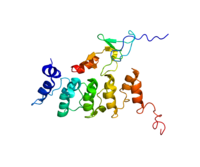
Photo from wikipedia
Upon pathogen recognition, a transient rise in cytoplasmic calcium levels is one of the earliest events in plants and a prerequisite for defense initiation and signal propagation from a local… Click to show full abstract
Upon pathogen recognition, a transient rise in cytoplasmic calcium levels is one of the earliest events in plants and a prerequisite for defense initiation and signal propagation from a local site to systemic plant tissues. However, it is unclear if calcium signaling differs in the context of priming: Do plants exposed to a first pathogen stimulus and have consequently established systemic acquired resistance (SAR) display altered calcium responses to a second pathogen stimulus? Several calcium indicator systems including aequorin, YC3.6 or R-GECO1 have been used to document local calcium responses to the bacterial flg22 peptide but systemic calcium imaging within a single plant remains a technical challenge. Here, we report on an experimental approach to monitor flg22-induced calcium responses in systemic leaves of primed plants. The calcium-dependent protein kinase CPK5 is a key calcium sensor and regulator of the NADPH oxidase RBOHD and plays a role in the systemic calcium-ROS signal propagation. We therefore compared flg22-induced cytoplasmic calcium changes in Arabidopsis wild-type, cpk5 mutant and CPK5-overexpressing plants (exhibiting constitutive priming) by introgressing the calcium indicator R-GECO1-mTurquoise that allows internal normalization through mTurquoise fluorescence. Aequorin-based analyses were included for comparison. Based on the R-GECO1-mTurquoise data, CPK5-OE appears to reinforce an “oscillatory-like” Ca2+ signature in flg22-treated local tissues. However, no change was observed in the flg22-induced calcium response in the systemic tissues of plants that had been pre-challenged by a priming stimulus – neither in wild-type nor in cpk5 or CPK5-OE-lines. These data indicate that the mechanistic manifestation of a plant immune memory in distal plant parts required for enhanced pathogen resistance does not include changes in rapid calcium signaling upstream of CPK5 but rather relies on downstream defense responses.
Journal Title: Frontiers in Plant Science
Year Published: 2021
Link to full text (if available)
Share on Social Media: Sign Up to like & get
recommendations!